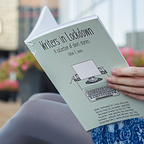Book review: The Truth About Sharks and Pigeons, by Matt Phillips
How do I feel about this book? I hate stabbing things because the authors try so hard and take it personally but I guess most of the sales of this title have already happened and it won’t make much difference if I do my job the way I should, as a reviewer.
The ordinary animal that suddenly speaks to a human, a pigeon, instantly made me think the author had read and enjoyed Expecting Someone Taller by Tom Holt, in which a badger gets run over and then unexpectedly speaks to the driver. This was an original surprise in 1987, when Holt did it. Tom Holt’s book wasn’t superficial either because it was set against the background mythology of three Wagner operas and his badger was a parody of Fasolt or Fafner, but this scene is built on no sort of cultural or intellectual foundation like that. Is it commendable when a piece of theatre that operates on two levels is recreated years later on only one? This isn’t a direct accusation of copying, just a suspected strong influence which may even have been subconscious. Tom Holt’s matter transporter is the Tarnhelm (more Wagner mythology). In this book it’s a matter transporter.
“What the hell’s that”, near the start, immediately made me think of Arthur Dent using the same line when he encounters the Dentrassi. I’m sure it’s been in a lot of other things too but, seeing as the author has read or seen the same cultural influences as I have and even my parents can quote from and he so dearly wants to be just like them, the other writers not my parents, it’s a fair bet the voice in the author’s head when he reads his own line aloud belongs to the actor Simon Jones. It doesn’t end there. In the Hitchhiker’s Guide, talking white mice secretly run the world and humans have completely misinterpreted their relationship with them due to their successful designs and intrigues that were intended to keep it that way. The similarity with this is that a different species of talking creatures secretly run the world and humans have completely misinterpreted their relationship with them due to their successful designs and intrigues that were intended to keep it that way. Subconscious again, she said, defending the author.
The use of an unlikely hero is fair enough and isn’t copying and aping because it’s a popular style. I prefer unlikely heroes, beta people, and many others would agree, including this author. Tom Holt always wrote unlikely heroes (except in Ye Gods, which sent up heroes) and so did Douglas Adams, so I think the author likes them both and thought it works out better this way, which it does of course. Other countries have the capable alpha hero and the hometown best friend but the English style is to dispense with the hero completely and drop the best friend right in it up to their neck. I think this writer’s choices have been formed around how other humourists have entertained him, so it’s not wrong and it’s good for the story and I wouldn’t want it changed but he is following an existing format without trying to stamp his individual style onto anything and make any theme in this book his alone, which he should try to do if he wants to stand in this sort of company. This is not a pioneering work, is it? Perhaps a comfortable re-tread. The story doesn’t say anything or do anything I object to. It just meanders along and involves a lot of talking animals, which fails to be unexpected when you’re into the third species.
Let’s recap: Inferior to the authors he’s been influenced by and is trying to emulate. Friendly and bonkers, well intended, by someone who wants you to like it and them, but disappointing. Sort of fun but a wobbly fairground mirror reflection of what he was trying for. I want to read originality.
Is it funny though? I found two good laughs and they were good but two is two, last time I counted, and I get more laughs than that giving head. The idea with the mark they put on the hero’s forehead is funny slapstick and I did laugh out loud. The slinky in the torture chamber is sleek and effective humour, probably the high point of the book. You buy it, you take your chance, but if this publication ever gets reprinted and he puts “laugh out loud” or “sleek and effective humour” with the critics’ quotes on the back, I wouldn’t find that very amusing.
